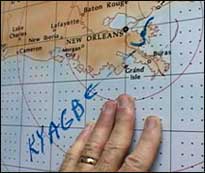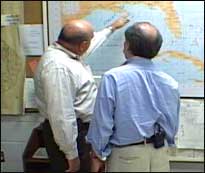And just across the Mississippi River, Walter Maestri is struggling to help New Orleans prepare. Maestri is the czar of public emergencies in Jefferson Parish (that's the county that sprawls across a third of the metropolitan area). He points to a map of the region on the wall of his command post.
"A couple of days ago," explains Maestri, "We actually had an exercise where we brought a fictitious Category Five Hurricane into the metropolitan area."
| |

When the computer models showed Walter Maestri what would happen after a hurricane hit New Orleans, he wrote big letters on the map:
"KYAGB—kiss your ass good bye." Photo: William Brangham/NOW with Bill Moyers |
The map is covered with arrows and swirls in erasable marker. They show how the fictitious hurricane crossed Key West and then smacked into New Orleans.
When the computer models showed Maestri what would happen next, he wrote big letters on the map, all in capitals.
"KYAGB—kiss your ass good bye," reads Maestri.
"Because," says Maestri, "anyone who was here when that storm came across was gone—it was body-bag time. We think 40,000 people could lose their lives in the metropolitan area."
And some scientists say that figure is conservative. People have known for centuries that New Orleans is a risky spot — the biggest river in North America wraps around it; and most of the land is below sea level. But researchers say they've been learning just how grave the problem is, only in the last few years. And they say the city and the nation aren't prepared to handle it.
To begin to understand why, we clamber up the levees along the Mississippi River. Our guide is Oliver Houck, who runs the environment program at Tulane
University Law School.
Houck describes it, "There's no place in the world that has a levee system that is as extensive as this one—it's a monster system."

Walter Maestri thinks 40,000 people could lose their lives in the metropolitan area if a hurricane were to hit. Photo: William Brangham/NOW with Bill Moyers | |
The U.S. Army built this monster system we're standing on. Since the late 1800s, the Army Corps of Engineers has built more than 2,000 miles of high, grassy embankments, along the Mississippi and its branches.
"This levee system is to levees around the world, the way that the Great Wall of China is to walls around the world," continues Houck. "There are other walls and then there is The Wall. There are other levees and then there is The Levee system.
The Army built it because storms over the Mississippi used to cause massive floods. Back in the 1920s, the river gushed over its banks and killed thousands of people and forced a million to abandon their homes.
"It was always thought that the big threat of flooding in New Orleans was the river—and it was—because it flooded regularly," explains Houck. "So we beat flooding by taming the river. The irony of history has been that we—like one of those old citadels in an adventure story— defended ourselves against the enemy that we knew, which was the river, but to the rear and to the flank was this other threat, which we are only now beginning to appreciate, and it may be too late to prevent.
Next: Preparing for Category Five

